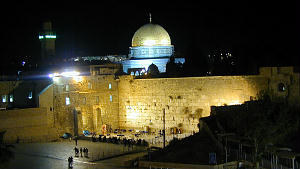 |
Jerusalem (old City) by Night |
| After dinner on Tuesday, we were offered an optional tour
of the old city of Jerusalem by night (for an extra fee of course).
We started in the bus and stopped briefly to the East of the Old Town in the Kidron Valley, otherwise known as the valley of the kings from where we were able to see
|
|
| Back in the coach, we drove round the walls of the Old
City and were dropped near the Zion Gate (Sha'ar Ziyyon), still bearing
the scars of many conflicts, most recently the 1948 war which resulted
in the founding of the modern state of Israel. To the right of the gate
is a memorial plaque to those who fell.
Once through the gate, we skirted the edge of the Armenian Quarter and walked through the Jewish Quarter. |
|
| The Cardo Maximus was the main street of Roman Jerusalem. The Southern section has been excavated and restored to more or less its original state, a collonnaded avenue with roofed arcades on either side. | |
| I am not sure of the original of the Gold Menorah in a glass display case in the old excavated Cardo area. | |
| Kust East of the Cardo is an important but relatively insignificant looking hole in the ground. On one side there are the remains of a fortified stone wall dating back to to the time of King Hezekiah and the First Temple, around 701 BC. | |
| A more modern artefact is the post box dating back to the first half of the 20th century and British rule in Israel. | |
| Our final destination was the Western Wall (Wailing Wall). To reach this we had to walk down a staircase called, Ma'alot Rabi Yehuda Hulevi past this ruined arch. To get into the open space in front of the Western Wall, it was necessary to pass through metal detectors, a grim reminder of the tensions lurking just below the surface which erupted into violence less than a year after our visit. | |
| The Western Wall is the only remaining fragment of the 2nd
Temple and represents the Jewish holiest place. Immediately behind it is
Temple Mount and the El Aqsa Mosque, after Mecca the second most hold
place for Muslims, and less than 1km from the Church of the Holy
Sepulchre.
By night, the floodlit wall was much more impressive than by day. The wall itself is divided into separate sections for men and women. Even late in the evening it was a busy place. To approach the wall, we had to wear head coverings. Unlike many of the other places we visited in Israel, which were simply treated like tourist attractions, there was an atmosphere around the wall that encouraged everyone to treat it with reverence. |
|
| As we left the square, we were once again reminded of both the security situation and the local culture. The exit (and entrance) were segregated with different routes for men and women. |
Last updated on July 09, 2001